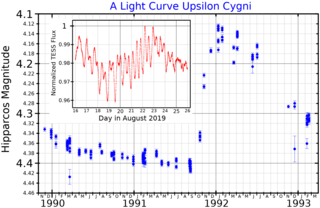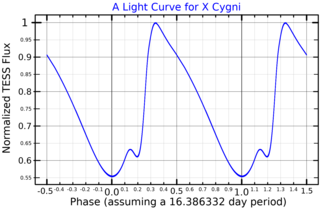
61 Cygni is a binary star system in the constellation Cygnus, consisting of a pair of K-type dwarf stars that orbit each other in a period of about 659 years. Of apparent magnitude 5.20 and 6.05, respectively, they can be seen with binoculars in city skies or with the naked eye in rural areas without light pollution.

Messier 39 or M39, also known as NGC 7092, is an open cluster of stars in the constellation of Cygnus, positioned two degrees to the south of the star Pi Cygni and around 9° east-northeast of Deneb. The cluster was discovered by Guillaume Le Gentil in 1749, then Charles Messier added it to his catalogue in 1764. When observed in a small telescope at low power the cluster shows around two dozen members but is best observed with binoculars. It has a total integrated magnitude (brightness) of 5.5 and spans an angular diameter of 29 arcminutes – about the size of the full Moon. It is centered about 1,010 light-years away.
16 Cygni or 16 Cyg is the Flamsteed designation of a triple star system approximately 69 light-years away from Earth in the constellation of Cygnus. It consists of two Sun-like yellow dwarf stars, 16 Cygni A and 16 Cygni B, together with a red dwarf, 16 Cygni C. In 1996 an extrasolar planet was discovered in an eccentric orbit around 16 Cygni B.

RV Tauri is a star in the constellation Taurus. It is a yellow supergiant and is the prototype of a class of pulsating variables known as RV Tauri variables. It is a post-AGB star and a spectroscopic binary about 4,700 light years away.
Pi1 Cygni (π1 Cygni, abbreviated Pi1 Cyg, π1 Cyg) is a binary star in the northern constellation of Cygnus. It is visible to the naked eye, having a combined apparent visual magnitude of 4.66. The distance to this system can be roughly gauged by its annual parallax shift of 1.89 mas, which yields a separation of around 1,700 light years from the Sun, give or take a hundred light years.

16 Cygni Bb or HD 186427 b is an extrasolar planet approximately 69 light-years away in the constellation of Cygnus. The planet was discovered orbiting the Sun-like star 16 Cygni B, one of two solar-mass (M☉) components of the triple star system 16 Cygni in 1996. It orbits its star once every 799 days and was the first eccentric Jupiter and planet in a double star system to be discovered. The planet is abundant in lithium.

Delta Cygni is a binary star of a combined third-magnitude in the constellation of Cygnus. It is also part of the Northern Cross asterism whose brightest star is Deneb. Based upon parallax measurements obtained during the Hipparcos mission, Delta Cygni is located roughly 165 light-years distant from the Sun.

32 Cygni is the Flamsteed designation for a binary star system in the Cygnus constellation. It is a 4th magnitude star, which can be seen with the naked eye under suitably dark skies. Parallax measurements give an estimated distance of 1,100 light-years (320 parsecs) from the Earth. However, Schröder et al. (2007) suggest the actual value, after correcting for Malmquist bias, may be closer to 1,174 light-years (360 parsecs). Although it is a spectrsocopic binary with components that cannot be separated visually, it has two entries in the Henry Draper Catalogue, with identical magnitudes and positions, but showing the spectral types of the two components.

RT Andromedae is a variable star in the constellation of Andromeda. The system is estimated to be 322 light-years away.

V404 Cygni is a microquasar and a binary system in the constellation of Cygnus. It contains a black hole with a mass of about 9 M☉ and an early K giant star companion with a mass slightly smaller than the Sun. The star and the black hole orbit each other every 6.47129 days at fairly close range. Due to their proximity and the intense gravity of the black hole, the companion star loses mass to an accretion disk around the black hole and ultimately to the black hole itself.

Upsilon Cygni, Latinized from υ Cygni, is a star in the northern constellation of Cygnus. It is visible to the naked eye, having an apparent visual magnitude of 4.43. Based upon an annual parallax shift of 5.0 mas, it lies at a distance of roughly 650 light years from the Sun.

TU Muscae, also known as HD100213, is an eclipsing binary star in the constellation Musca. Its apparent magnitude ranges from 8.17 to 8.75 over around 1.4 days.

31 Cygni, also known as ο1 Cygni, Omicron1 Cygni, or V695 Cygni, is a triple star system about 750 light years away in the constellation Cygnus.

AB Andromedae is a binary star in the constellation Andromeda. Paul Guthnick and Richard Prager discovered that the star is an eclipsing binary in 1927. Its maximum apparent visual magnitude is 9.49 but shows a variation in brightness down to a magnitude of 10.46 in a periodic cycle of roughly 8 hours. The observed variability is typical of W Ursae Majoris variable stars, so the two stars in this system form a contact binary.

V752 Centauri is multiple star system and variable star in the constellation of Centaurus. An eclipsing binary, its apparent magnitude has a maximum of 9.10, dimming to 9.66 during primary eclipse and 9.61 during secondary eclipse. Its variability was discovered by Howard Bond in 1970. From parallax measurements by the Gaia spacecraft, the system is located at a distance of 410 light-years from Earth.

TX Ursae Majoris is an eclipsing binary star system in the northern circumpolar constellation of Ursa Major. With a combined apparent visual magnitude of 6.97, the system is too faint to be readily viewed with the naked eye. The pair orbit each other with a period of 3.063 days in a circular orbit, with their orbital plane aligned close to the line of sight from the Earth. During the primary eclipse, the net brightness decreases by 1.74 magnitudes, while the secondary eclipse results in a drop of just 0.07 magnitude. TX UMa is located at a distance of approximately 780 light years from the Sun based on parallax measurements, but is drifting closer with a mean radial velocity of −13 km/s.

EQ Tauri is a triple star system in the equatorial constellation of Taurus that includes a contact eclipsing binary. The system is too faint to be viewed with the naked eye, having a baseline apparent visual magnitude of 10.5. During the primary eclipse, the brightness of the system drops to magnitude 11.03, then to 10.97 during the secondary minimum. The secondary eclipse is total. Based on parallax measurements, it is located at a distance of approximately 730 light years from the Sun.

VV Ursae Majoris is a binary star system in the northern circumpolar constellation of Ursa Major, abbreviated VV UMa. It is a variable star system with a brightness that cycles around an apparent visual magnitude of 10.19, making it too faint to be visible to the naked eye. The system is located at a distance of approximately 1,500 light years based on parallax measurements.

X Cygni is a variable star in the northern constellation of Cygnus, abbreviated X Cyg. This is a Delta Cephei variable that ranges in brightness from an apparent visual magnitude of 5.85 down to 6.91 with a period of 16.386332 days. At it brightest, this star is dimly visible to the naked eye. The distance to this star is approximately 628 light years based on parallax measurements. It is drifting further away with a radial velocity of 8.1 km/s. This star is a likely member of the open cluster Ruprecht 173.

SU Cygni is a triple star system in the northern constellation of Cygnus, abbreviated SU Cyg. The primary component of the system is a classical Cepheid variable with a period of 3.8455473 days. The changing luminosity of this star causes the system to vary in brightness from a peak apparent visual magnitude of 6.44 down to magnitude 7.22 over the course of its cycle. The distance to this system is approximately 3,200 light years based on parallax measurements. It is a member of the Turner 9 open cluster of stars.















